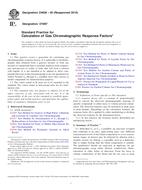Potřebujeme váš souhlas k využití jednotlivých dat, aby se vám mimo jiné mohly ukazovat informace týkající se vašich zájmů. Souhlas udělíte kliknutím na tlačítko „OK“.
ASTM D4626-95(2010)
Standard Practice for Calculation of Gas Chromatographic Response Factors
Automaticky přeložený název:
Standardní praktiky pro výpočet plynové chromatografie faktory odezvy
NORMA vydána dne 1.10.2010
Informace o normě:
Označení normy: ASTM D4626-95(2010)
Poznámka: NEPLATNÁ
Datum vydání normy: 1.10.2010
Kód zboží: NS-27938
Počet stran: 3
Přibližná hmotnost: 9 g (0.02 liber)
Země: Americká technická norma
Kategorie: Technické normy ASTM
Anotace textu normy ASTM D4626-95(2010) :
Keywords:
gas chromatography, response factor, Flame ionization detectors (FID), Gas chromatography (GC), Gas chromatography (GC)--petroleum products, Liquids, Measurement processes/systems, Petroleum products, Response factors, Thermal conductivity detectors (TCD), ICS Number Code 71.040.50 (Physicochemical methods of analysis)
Doplňující informace
| Significance and Use | ||||||||||||||||||||||
|
ASTM standard gas chromatographic methods for the analysis of petroleum products require calibration of the gas chromatographic system by preparation and analysis of specified reference mixtures. Frequently, minimal information is given in these methods on the practice of calculating calibration or response factors. Test Methods D2268, D2427, D2804, D2998, D3329, D3362, D3465, D3545, and D3695 are examples. The present practice helps to fill this void by providing a detailed reference procedure for calculating response factors, as exemplified by analysis of a standard blend of C6 to C11 n-paraffins using n-C12 as the diluent. In practice, response factors are used to correct peak areas to a common base prior to final calculation of the sample composition. The response factors calculated in this practice are “multipliers” and prior to final calculation of the results the area obtained for each compound in the sample should be multiplied by the response factor determined for that compound. It has been determined that values for response factors will vary with individual installations. This may be caused by variations in instrument design, columns, and experimental techniques. It is necessary that chromatographs be individually calibrated to obtain the most accurate data. |
||||||||||||||||||||||
| 1. Scope | ||||||||||||||||||||||
|
1.1 This practice covers a procedure for calculating gas chromatographic response factors. It is applicable to chromatographic data obtained from a gaseous mixture or from any mixture of compounds that is normally liquid at room temperature and pressure or solids, or both, that will form a solution with liquids. It is not intended to be applied to those compounds that react in the chromatograph or are not quantitatively eluted. Normal C6 through C11 paraffins have been chosen as model compounds for demonstration purposes. 1.2 The values stated in SI units are to be regarded as the standard. The values stated in inch-pound units are for information only. 1.3 This standard does not purport to address all of the safety concerns, if any, associated with its use. It is the responsibility of the user of this standard to establish appropriate safety and health practices and determine the applicability of regulatory limitations prior to use. |
||||||||||||||||||||||
| 2. Referenced Documents | ||||||||||||||||||||||
|
Doporučujeme:
Aktualizace technických norem
Chcete mít jistotu, že používáte pouze platné technické normy?
Nabízíme Vám řešení, které Vám zajistí měsíční přehled o aktuálnosti norem, které používáte.
Chcete vědět více informací? Podívejte se na tuto stránku.




 Cookies
Cookies
